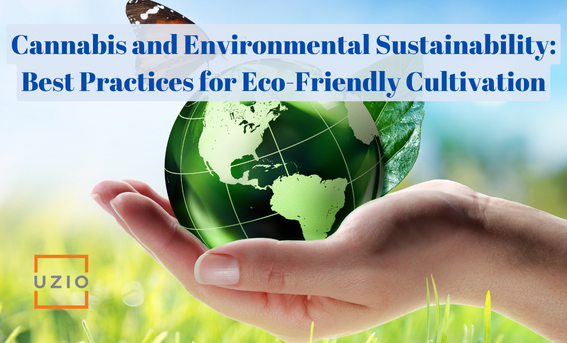
Cannabis and Environmental Sustainability: Best Practices for Eco-Friendly Cultivation
Quick links
-
Introduction
-
Sustainability in the Cannabis Industry: Truly Going Green
-
Major Sources of Waste and Their Mitigation
-
How Much Plastic Waste Does the Cannabis Industry Produce?
-
Sustainable Practices in the Cannabis Industry
-
Addressing the Environmental Impact
-
The Path Forward: Eco-Friendly Cannabis Cultivation
1. Introduction
The cannabis industry is at a pivotal crossroads, where the demand for cannabis products is increasing alongside a growing consciousness about environmental sustainability. This comprehensive guide delves into the challenges and solutions at the heart of eco-friendly cannabis cultivation, aiming to inspire a shift towards more sustainable practices within the industry.
2. Sustainability in the Cannabis Industry: Truly Going Green
The journey towards sustainability in cannabis cultivation is multifaceted, addressing everything from waste reduction to energy efficiency. The goal is clear: to minimize environmental impact while still meeting consumer demand.
3. Major Sources of Waste and Their Mitigation
- Chemical Fertilizers and Pesticides: The traditional reliance on chemical fertilizers and pesticides in agriculture has been a significant environmental concern. In cannabis cultivation, the shift towards organic and natural farming practices not only supports the ecosystem’s health but also appeals to consumers seeking cleaner, greener products.
- Fibrous Waste: Cannabis cultivation generates considerable fibrous waste, which, if not properly managed, can contribute to environmental degradation. Innovative solutions like converting cannabis waste into hempcrete for construction projects offer a sustainable alternative, showcasing the industry’s potential for circular economy practices.
- Packaging: Excessive packaging, particularly non-recyclable plastics, remains a significant issue. Embracing green packaging solutions—such as biodegradable materials and minimalist designs—can significantly reduce the industry’s environmental footprint.
4. How Much Plastic Waste Does the Cannabis Industry Produce?
The cannabis industry, while burgeoning in both medical and recreational sectors, has inadvertently contributed to the global plastic waste dilemma. The stringent regulations surrounding cannabis packaging, aimed at ensuring child safety and product freshness, have led to an over-reliance on single-use plastics. Many products come double or triple wrapped in non-recyclable plastics, significantly increasing the industry’s environmental footprint. Reports suggest that the sector generates a considerable amount of plastic waste, with dispensaries often handing out products in multiple layers of packaging. Simply put, the cannabis industry has a waste problem, particularly in the form of plastic packaging.
A single gram of cannabis comes with an average of 70 grams of packaging waste, primarily in the form of single-use plastics. The challenge lies in balancing regulatory compliance with environmental sustainability, prompting a call for innovations in biodegradable and recyclable packaging solutions tailored to the cannabis industry.
Recommended Reading: Top-7 Cannabis Trends to Watch out for in 2024
5. Sustainable Practices in the Cannabis Industry
-
Regenerative Farming: This approach goes beyond sustainability, aiming to actively regenerate degraded soils, increase biodiversity, and improve the water cycle. It represents a holistic view of cannabis cultivation as part of a larger ecosystem.
-
Renewable Energy: The high energy consumption of indoor cannabis cultivation facilities is a well-documented issue. Transitioning to renewable energy sources, such as solar or wind power, can dramatically reduce carbon emissions and operational costs in the long run.
-
Water Conservation: Cannabis is a water-intensive crop. Implementing efficient irrigation systems, such as drip irrigation, and practices like rainwater harvesting can significantly reduce water usage.
6. Addressing the Environmental Impact
The environmental impact of cannabis cultivation extends beyond the immediate vicinity of the farms. It encompasses energy use, water management, and the broader ecological footprint of the industry.
Energy Consumption and Efficiency:
Indoor cannabis cultivation is notorious for its high energy demand, primarily due to lighting and climate control systems. Advances in energy-efficient LED lighting and climate control technologies offer paths toward reducing this demand, while the integration of solar panels can offset energy use with renewable sources.
Water Use and Conservation:
Efficient water use is critical in cannabis cultivation. Techniques like rainwater harvesting and the use of water-efficient hydroponic systems can drastically reduce the amount of water needed, helping to preserve this precious resource.
Air Quality and Carbon Footprint:
The cannabis industry’s carbon footprint is an area of growing concern. Strategies for reducing this footprint include adopting clean energy, enhancing energy efficiency, and investing in carbon offset programs. Moreover, outdoor cultivation, where feasible, can significantly reduce energy consumption associated with artificial lighting.
Recycling and Waste Reduction:
Recycling and waste reduction are pivotal in mitigating the environmental impact of the cannabis industry. The sector faces unique challenges in waste management, particularly with the disposal of plant material and packaging. However, innovative solutions are emerging, from composting organic waste to repurposing cannabis by-products for industrial use. Some companies are exploring the production of hemp-based packaging, which is both sustainable and biodegradable, to replace conventional plastics. Additionally, recycling programs tailored to cannabis packaging are beginning to take shape, encouraging consumers to return used containers for proper disposal or repurposing. These efforts not only aim to reduce the industry’s carbon footprint but also align with the growing consumer demand for environmentally responsible practices.
The Role of Aquaponics and Hydroponics in Sustainable Cannabis Farming:
Aquaponics and hydroponics represent groundbreaking shifts towards sustainable cannabis cultivation, drastically reducing water usage and eliminating the need for chemical fertilizers. Aquaponics combines fish farming with plant cultivation, where fish waste provides organic nutrients for the plants, which in turn purify the water for the fish. This closed-loop system not only conserves water but also creates a symbiotic environment for both plants and aquatic life. Hydroponics, on the other hand, involves growing plants in a nutrient-rich water solution, sans soil. This method allows for precise control over nutrients and pH levels, enhancing growth rates and yields. Both systems exemplify eco-friendly practices by promoting water conservation, reducing runoff, and enabling year-round cultivation with minimal environmental impact.
7. The Path Forward: Eco-Friendly Cannabis Cultivation
The path to sustainability in the cannabis industry is both challenging and rewarding. By embracing eco-friendly cultivation practices, the industry can mitigate its environmental impact, meet regulatory requirements, and cater to the growing demand for sustainable products. This shift requires commitment, innovation, and collaboration among growers, regulators, and consumers alike.
The future of cannabis cultivation lies in its ability to integrate with the principles of environmental stewardship. As the industry evolves, adopting sustainable practices will not only be a matter of regulatory compliance but also a competitive advantage in the burgeoning cannabis market. Through concerted efforts, the cannabis industry can contribute positively to the global movement towards environmental sustainability, setting a precedent for other agricultural sectors to follow.
Get in touch with us for an expert-led demo to know more about UZIO all-in-one payroll software.





